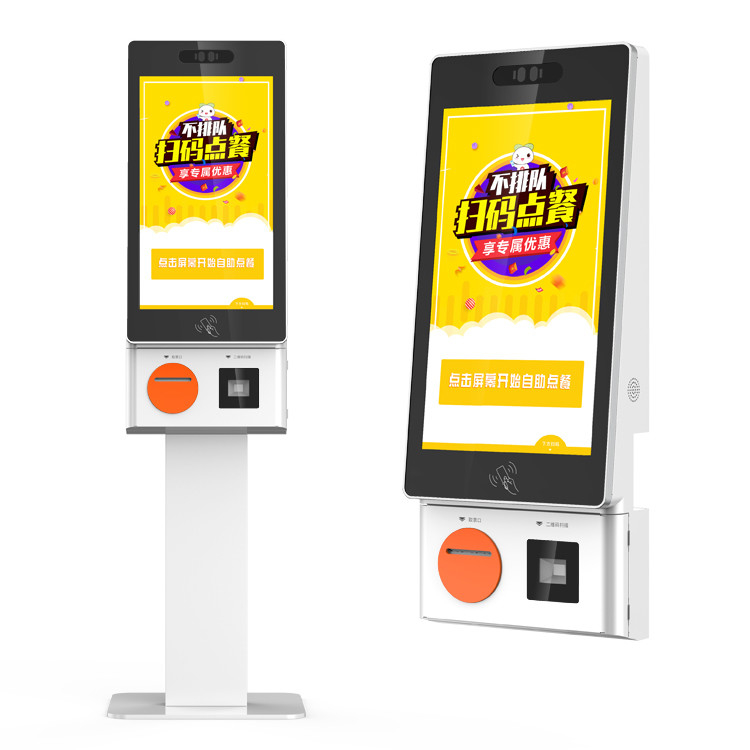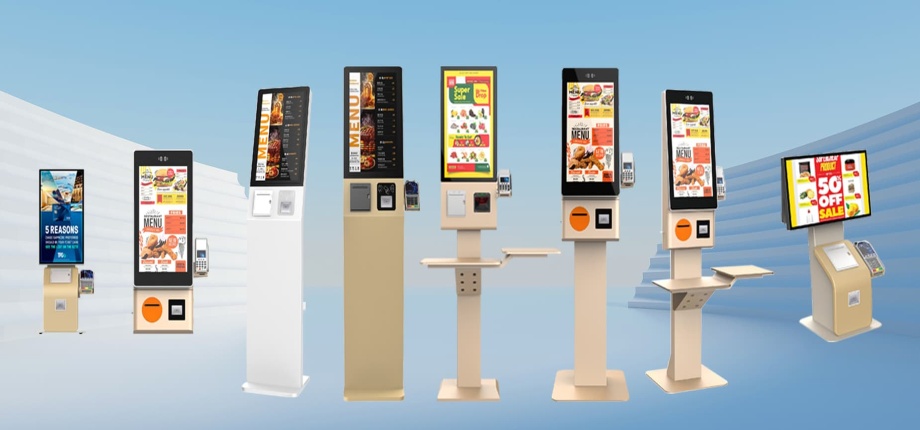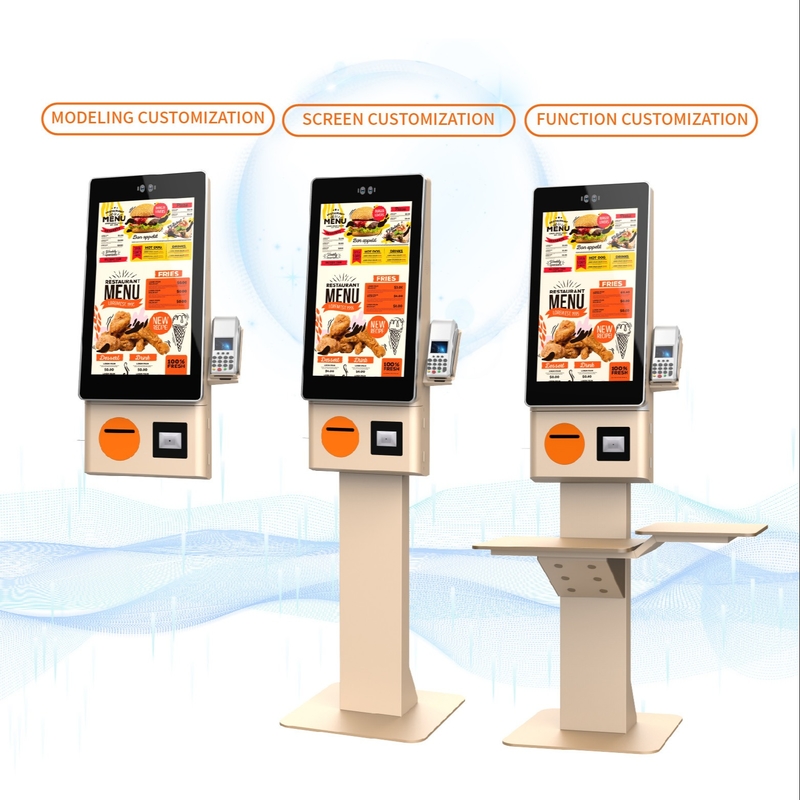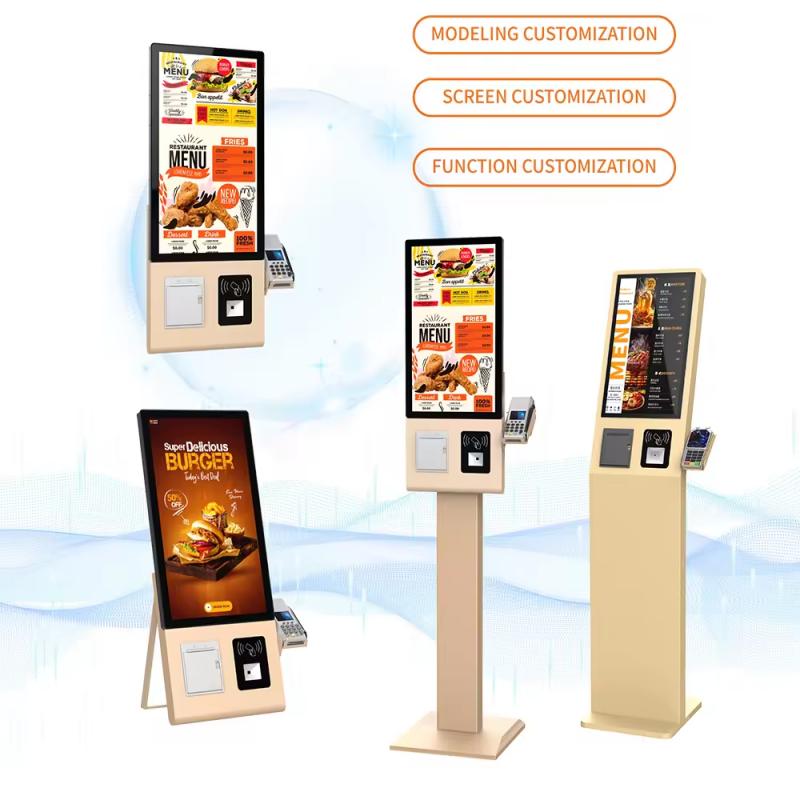





McDonalds kiosk is a self-service digital machine designed to enhance the customer experience by streamlining the ordering and payment process. These kiosks allow customers to browse the menu, customize their orders, select promotions, and make secure payments via card, NFC, or mobile payment methods. Key components include a high-resolution touchscreen, user-friendly software, and integrated payment systems. The kiosks help reduce wait times, minimize order errors, and improve overall service efficiency, offering a faster, more convenient, and personalized dining experience.
Welcome to our McDonalds Kiosk faqs homepage! With over 10 years of experience in the kiosk industry, we deeply understand the diverse questions and needs that different groups may have about McDonalds kiosk. As an authoritative kiosk manufacturing expert, we not only provide high-quality Mcdonalds kiosk products but also offer professional consultations, industry insights, and technical knowledge sharing. Below, we've compiled McDonalds kiosk FAQs from the perspectives of buyers, manufacturers, users, and scholars. We invite you to explore, engage, and interact with us as we strive to become the world’s top McDonald's kiosk supplier.

Look for user-friendly touchscreens, secure payment systems, customization options, and integration with McDonald’s POS systems.
Prices vary based on features, customization, and supplier. Expect costs between $5,000 and $15,000.
Yes, McDonald’s kiosks can be customized to fit specific location needs and branding requirements.
Delivery time usually ranges from 6 to 12 weeks, depending on customization and supplier availability.
Yes, McDonald's kiosks typically come with warranties covering hardware and software, with options for extended support.
Regular cleaning, software updates, and hardware checks are necessary to ensure optimal performance.
Evaluate suppliers based on their experience, product quality, customer reviews, and support services.
Customization options include screen size, interface design, branding, and additional features like loyalty program integration.
The average lifespan is 5 to 7 years with proper maintenance and usage.
Contact suppliers directly with your requirements to receive a customized quote based on your needs.
Yes, McDonald’s kiosks are designed to integrate with existing POS and ordering systems.
Installation requires proper space, power connections, and network integration to function correctly.
Additional costs may include installation, maintenance, software updates, and customization.
Training typically includes user guides, on-site training, and support from the kiosk supplier.
Benefits include improved order accuracy, faster service, and enhanced customer experience.
Kiosks use encrypted payment systems and comply with industry security standards to protect transactions.
Some kiosks are designed for outdoor use with weather-resistant features, but check with suppliers for specific models.
Kiosks typically require standard electrical outlets and low power consumption, but verify specific needs with the supplier.
The kiosks can be configured to support multiple languages to cater to diverse customer bases.
Ensure the location meets size, power, and connectivity requirements for the kiosk.
Yes, kiosks can be upgraded with new software features and hardware components as needed.
Support typically includes troubleshooting, repairs, and software updates, available through the supplier.
Kiosks streamline ordering, reducing wait times and improving overall customer service efficiency.
Yes, many McDonald’s kiosks support mobile payment options like Apple Pay and Google Wallet.
Follow the supplier’s warranty process, which usually involves contacting their support team and providing necessary documentation.
Common issues include software glitches, touchscreen calibration problems, and payment processing errors.
Some kiosks are designed for drive-thru use, but check specific models and configurations with the supplier.
Service frequency depends on usage, but regular checks every 3 to 6 months are recommended.
Benefits include consistent customer experience, increased order accuracy, and efficient service.
Kiosks are designed for high throughput, with efficient processing to handle peak times.

McDonald's kiosks use durable materials like stainless steel, high-grade plastics, and tempered glass.
Testing includes functionality checks, user interface evaluations, and integration with POS systems.
Security features include encrypted payment processing, secure data storage, and compliance with industry standards.
Kiosks include features such as adjustable screen heights, voice guidance, and large text options for accessibility.
Customizations include screen size, design elements, software features, and branding options.
Key components include a touchscreen display, payment terminal, printer, and computer system.
Software integrates with McDonald’s POS systems for seamless order processing and real-time updates.
Maintenance includes cleaning, software updates, hardware checks, and addressing any technical issues.
The UI is designed for ease of use, with intuitive navigation, customizable options, and clear visual feedback.
Common issues include software bugs, hardware malfunctions, and connectivity problems.
Yes, kiosks can receive remote software updates to ensure they have the latest features and security patches.
Kiosks are shipped in secure packaging and installed by professional technicians who ensure proper setup.
Training includes user guides, on-site sessions, and support for troubleshooting and maintenance.
Payment security is managed through encryption, secure processing systems, and compliance with payment industry standards.
Kiosks generally have low power consumption and require standard electrical outlets for operation.
Kiosks are built to handle high volumes of orders efficiently, with robust hardware and optimized software.
Features include adjustable text sizes, voice prompts, and high-contrast screens for users with disabilities.
Testing involves ensuring accessibility features meet legal standards and provide a user-friendly experience.
Yes, kiosks can be upgraded with new technology, including advanced payment systems and enhanced software features.
The average lifespan is 5 to 7 years, depending on usage and maintenance.
Kiosks support multiple languages through software settings, allowing users to select their preferred language.
Support includes troubleshooting, repair services, and software updates provided by the kiosk supplier.
Considerations include energy efficiency, recyclable materials, and compliance with environmental regulations.
Durability testing involves stress tests, impact resistance evaluations, and long-term usage simulations.
Design considerations include user ergonomics, visual clarity, and integration with McDonald’s branding.
Software updates are managed remotely or through scheduled maintenance to ensure kiosks run the latest versions.
Common components include touchscreen monitors, payment readers, printers, and internal computing systems.
Software reliability is tested through rigorous quality assurance processes, including stress testing and user simulations.
Safety features include tamper-resistant designs, secure wiring, and compliance with electrical safety standards.
Kiosks are engineered to function in various environments, including indoor and outdoor settings, with features like weather resistance and robust construction.

Touch the screen to begin, select your language, and follow the prompts to place your order.
Yes, McDonald’s kiosks allow you to modify items, add extras, and customize your meal to your preferences.
Look for on-screen help options or ask a staff member for assistance if you encounter any issues.
Choose your payment method, such as credit/debit card or mobile payment, and follow the instructions on the screen.
Yes, select "Use at Restaurant" and scan your coupon code at the kiosk to apply the discount.
You will receive a confirmation screen with your order details and an estimated wait time.
The kiosk will provide real-time updates on your order status and estimated completion time.
Notify a staff member immediately to correct the issue with your order.
Choose "Use at Restaurant," then scan your deal code at the kiosk or enter it manually if prompted.
Yes, the interface is designed to be intuitive and user-friendly for people of all ages.
Yes, the kiosk may allow you to save and quickly reorder your favorite items.
If the kiosk is not working, place your order at the counter or another available kiosk.
Some kiosks integrate with McDonald’s loyalty programs, allowing you to check and redeem rewards.
Contact McDonald’s customer service via their website or ask a staff member for assistance.
Most locations have kiosks, but availability may vary depending on the restaurant.
The kiosk supports multiple languages; select your preferred language from the menu.
Yes, nutritional information for menu items is often available on the kiosk screen.
Use the feedback option on the kiosk or contact McDonald’s customer service online.
Changes typically need to be made before you finalize and pay for the order.
Use the "Cancel" option to start over or correct the item before proceeding to payment.
Kiosks are usually for in-store orders; use the McDonald’s app or website for delivery orders.
You can customize your order to accommodate dietary needs by selecting options on the kiosk.
Ensure the touchscreen is responsive and displays the correct options; ask for help if something seems off.
Many kiosks allow for single payment transactions; check with staff if you need to split payments.
Kiosks are designed to handle high volumes efficiently, with features to speed up order processing.
Try a different payment method or ask for assistance from a staff member.
The kiosk screen often highlights current promotions and special offers during the ordering process.
Yes, gift cards are typically accepted at the kiosk; follow the on-screen instructions to redeem them.
Report the issue to a staff member who can address the problem or restart the kiosk if necessary.
Benefits include faster service, customization options, and a streamlined ordering process.

McDonald’s kiosks generally improve customer satisfaction by providing a quicker, more personalized ordering experience.
Kiosks enhance operational efficiency by reducing wait times and streamlining order processing.
Advancements include high-resolution touchscreens, integration with mobile payment systems, and advanced customization features.
Kiosks incorporate features like adjustable text sizes, voice guidance, and tactile feedback to support accessibility.
Kiosks collect data on customer preferences and ordering patterns, which can be used to improve service and marketing strategies.
Kiosks engage customers by offering interactive ordering experiences and personalized promotions.
Privacy considerations include secure handling of personal and payment information, with compliance to data protection regulations.
Kiosks can shift labor focus from order taking to customer service and food preparation, potentially affecting staffing needs.
Environmental impacts include energy consumption and electronic waste; efforts are made to use energy-efficient components and recyclable materials.
User experience is evaluated through usability testing, customer feedback, and performance metrics.
Cost-benefit analyses consider initial investment, operational savings, increased sales, and improved customer satisfaction.
Integration involves linking kiosk software with POS systems for seamless order processing and inventory management.
Best practices include user-centered design, intuitive interfaces, and ensuring accessibility and security features.
Kiosks may require updated training programs for employees to manage the technology and assist customers effectively.
Self-service kiosks empower customers by giving them control over their orders and reducing perceived wait times.
Design elements such as layout, color schemes, and interactive features can influence ease of use and customer satisfaction.
Drawbacks may include initial costs, maintenance requirements, and potential technology issues.
Kiosks enhance brand loyalty by offering consistent, personalized experiences and convenient ordering options.
Research methods include surveys, observational studies, and data analysis of kiosk usage and customer feedback.
Kiosks are designed to handle high volumes of orders efficiently, with features to speed up processing during peak times.
User feedback informs design improvements, software updates, and overall functionality enhancements.
McDonald’s kiosks align with trends such as digital transformation, self-service technology, and the integration of AI and machine learning for enhanced customer experiences.
Kiosks can shift social interactions by reducing face-to-face interactions with staff, potentially altering customer dynamics and engagement.
Kiosks influence layout and design by requiring dedicated space for technology and potentially changing the flow of customer movement within the restaurant.
Kiosks enhance transparency by providing clear information on menu items, prices, and order status, allowing customers to make informed decisions.
Kiosks support inclusivity by offering multilingual options, customizable interfaces, and accessibility features to accommodate diverse customer needs.
Long-term impacts include potential improvements in brand perception due to enhanced customer experiences and innovative service approaches.
Kiosks streamline the ordering process and reduce wait times by allowing customers to place orders quickly and efficiently without waiting in line.
Challenges include regular maintenance to ensure functionality, software updates, and addressing hardware issues that may arise.
Kiosks impact decision-making by providing clear, detailed information on menu items, enabling customers to make informed choices based on their preferences.
As a professional manufacturer of McDonalds kiosk, we pride ourselves on delivering top-quality products backed by years of industry experience and technical expertise. Our commitment to excellence extends beyond manufacturing—our team offers comprehensive consultation services, ensuring you have all the essential information about McDonald's kiosk, from screen sizes and payment methods to software customization and accessibility features. Our kiosks are designed for durability, energy efficiency, and seamless integration with your existing systems, making them highly reliable for high-traffic environments.
We understand that every restaurant's needs are unique, which is why we offer tailored solutions, from design to implementation. Our kiosks are not only visually appealing but also equipped with the latest technology to provide fast, efficient, and secure service to your customers. With extensive after-sales support and warranties, we ensure long-term reliability and value for your investment.
Whether you're looking to upgrade your ordering system or need expert advice on optimizing your restaurant's operations, we are the trusted partner you can rely on for innovative McDonalds kiosk solutions.
Address: No. 99-15, Fuan intelligent manufacturing Industrial Park, Dayang Road, Fuhai Street, Baoan District, Shenzhen, China